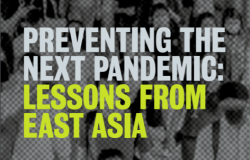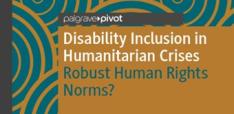Learning and Remembering: How East Asia Prepared for COVID-19 over the Years

By almost any standard, East Asia has dealt with COVID-19 better than Europe and the United States so far: death rates are lower, healthcare systems have not been overwhelmed, and there have been no countrywide full lockdowns. What explains their relative success?
Some pundits have pointed out that culture is behind East Asia’s good performance, especially Confucianism. Others have focused on social behaviour, specifically the idea that people across East Asia are more ‘obedient’ and ‘community-oriented’ whereas Europeans and Americas are ‘individualistic’. Another group of pundits has argued that it is the political system that matters, and specially the authoritarian or post-authoritarian nature of East Asian countries.
These explanations, however, fall short of offering a convincing explanation. Arguing that Confucianism explains East Asia’s success would be as implausible as the argument that Europe’s and the United States’ failures stem from their Christian roots; no serious study has yet offered evidence for such claims. As for social behaviour, weeks of economically and psychologically damaging lockdown suggest that European and the United States’ governments and populations are just as willing to put the wellbeing of the group – particularly the most vulnerable – ahead of individual interests. With regards to political systems, the EIU Democracy Index shows that East Asian countries include a wide range of strong democracies and highly authoritarian regimes, without a clear pattern of failure or success in one or the other.
 In an attempt to offer more plausible explanations, our new report concludes that that a key reason behind East Asia’s success is institutional capacity. In other words, and as per the UN definition, the ability of an institution ‘to perform functions, solve problems and set and achieve objectives’.
In an attempt to offer more plausible explanations, our new report concludes that that a key reason behind East Asia’s success is institutional capacity. In other words, and as per the UN definition, the ability of an institution ‘to perform functions, solve problems and set and achieve objectives’.
By looking at the cases of Hong Kong, Japan, Singapore, South Korea, Taiwan, and countrywide China (after its initial failure in Wuhan), we demonstrate that institutions across these countries and territories were able to learn lessons from previous pandemics and maintain institutional memory. They were able to implement the lessons learnt – and tweak them as necessary – as soon as news of the current pandemic started to emerge from China.
So how can countries that have failed to contain the first wave of the pandemic replicate East Asia’s success in building and maintaining institutional capacity?
The past as a springboard for success
COVID-19 is not the first pandemic to hit East Asia. SARS, H1N1 and MERS hit different parts of the region over the past two decades, enabling learning and institutional capacity building.
In 2003, China, Hong Kong, Singapore and Taiwan were severely affected by SARS – another coronavirus pandemic. In 2009, Hong Kong, Japan, Singapore and Taiwan were heavily affected by H1N1, better known as the swine flu. In 2015, an epidemic of coronavirus MERS hit South Korea. These countries therefore had experience in dealing with disease outbreaks, epidemics and pandemics when COVID-19 reached them.
Crucially, however, countries across East Asia also learnt from pandemics elsewhere. This includes pandemics affecting other countries across East Asia, but also pandemics in other parts of the world such as Ebola. In other words, institutional capacity-building is not only the result of having gone throughout a pandemic before. Learning from others’ pandemics is both necessary and advisable.
Furthermore, lessons from the SARS outbreak of 2002-03 that led to the International Health Regulations (2005) taught most East Asian countries about the importance of working closely with the World Health Organisation and with each other. Hong Kong and Singapore, for example, have regular exchanges with the WHO. The infectious diseases agencies of China, Japan and South Korea, meet regularly. In April, there was an ASEAN+3 COVID-19 summit. This shows that countries across East Asia see the benefits of sharing their experiences even as a pandemic is ongoing.
Learning the right lessons
The SARS, H1N1 and MERS outbreaks exposed the inadequacies of existing institutional infrastructures to address pandemics coming from overseas. Countries across East Asia therefore launched domestic processes to understand how to strengthen their institutional capacity to address weaknesses.
And what lessons did East Asian countries learnt regarding the centrality of institutional capacity? As we explain in our report, these lessons can be grouped in five categories.
1. A strong emergency legal framework is a pre-requisite.
In general, countries across East Asia treat (potential) pandemics as emergencies to be managed until a solution is found or they filter out. Thus, there is a need for special legal frameworks that can be swiftly deployed until the outbreak is finished. Japan, South Korea or Taiwan, for example, had pre-existing emergency legal frameworks that they updated after they suffered from previous pandemics. In the case of China, the government developed an entirely new framework following SARS. When COVID-19 hit, these frameworks were activated and new laws were passed in China, Hong Kong, Singapore and Taiwan. Japan and South Korea, meanwhile, introduced amendments to existing legislation.
2. Clear decision-making and implementation structures are crucial.
East Asian countries have developed clear decision-making and implementation structures in case of pandemics. Without them, it is difficult to quickly take decisions and get them implemented. There are clear lines of command within government and across agencies. Bigger countries such as China, Japan, South Korea and Taiwan also have a clear division of tasks between central and local authorities. Importantly, East Asian countries have permanent agencies that coordinate decision-making and implementation.
3. Preparedness of public health institutions and the healthcare system are essential.
Public health institutions and the healthcare system need to be ready before a pandemic hits. Otherwise, they will be playing catch up. With regards to public health and disease control institutions, there are specialised agencies with know-how about infectious diseases across East Asia. In general, countries in the region also have advanced technological systems involving nationwide public health networks that centralise information, carry out surveillance and offer diagnostic capacity. Regarding the healthcare system, countries in the region learned the importance of training of medical professionals, the stockpiling of PPE and other necessary medical equipment, and the building of facilities to isolate and treat patients.
4. The healthcare system needs to be protected and free of disruptions to operate in the face of a pandemic
The healthcare system can act as one of the main routes for a pandemic to spread. This can make patients unwilling to go to hospitals for treatment. It can also reduce capacity as medical professionals get infected precisely when they are more needed. Across East Asia, countries have focused on making sure that medical professionals can make use of PPE and other necessary equipment. Countries such as Singapore and Taiwan, for example, also have detailed inventories of intensive-care and negative pressure rooms where patients can be placed.
5. Strong public health measures to contain the spread are necessary.
Based on the key principle that the only way to stop a pandemic is to make sure that there are no new cases, East Asian countries focus on active public health measures during the outbreak. Key measures include transparent communication, social norms around the use of masks and other protective equipment in public spaces, aggressive contact tracing, or the potential closure of schools and other public facilities. Strong border controls are also part of the public health toolkit.
Remembering the lessons
Lessons can be learnt; but they can also be forgotten. Institutions can become complacent if there are no new outbreaks. There can be personnel changes as professionals move along in their careers or retire – and the opposite, professionals who stay in post for decades can become complacent. Politicians can meddle with institutions when there is a change in government. As table 1 shows, countries across East Asia have established a clear institutional framework to make sure that lessons are not lost as a result of these or other issues.
Table 1. Key ministry, specialised agency and playbook to maintain institutional memory
|
Country/territory |
Ministry (or equivalent) |
Specialised agency |
Playbook |
|
China |
National Health Commission |
National Health Commission, Chinese Center for Disease Control and Prevention |
|
|
Hong Kong |
Department of Health |
Preparedness and Response Plan for Novel Infectious Disease of Public Health Significance |
|
|
Japan |
Ministry of Health, Labor and Welfare |
The National Action Plan for Pandemic Influenza and New Infectious Diseases |
|
|
Singapore |
Ministry of Health |
||
|
South Korea |
Ministry of Health and Welfare |
Infectious Disease Disaster: Crisis Management Standard Manual |
|
|
Taiwan |
Ministry of Health and Welfare |
National Health Command Center, Taiwan Centers for Disease Control |
National Influenza Pandemic Preparedness Plan, Influenza Pandemic Strategic Plan |
These frameworks include, crucially, depoliticised specialised agencies that collect, analyse and keep the lessons learnt from previous pandemics. They also have surveillance functions, keeping an eye on potential domestic and international outbreaks. They can also draw and update existing playbooks.
European countries and the United States also have these agencies. But they have limited recent experience in dealing with pandemics or epidemics. And their work seems to have been undermined over the years as governments prioritised other, seemingly more pressing issues. This means that these agencies were not central to policy-making before the COVID-19 pandemic hit.
In terms of mechanisms to maintain institutional memory, we shown in our report that four are more commonly employed: regular mandatory plans or reports, regular table-top emergency exercises, regular expert group issue-specific reports, and training and international cooperation. Countries across East Asia have been using these mechanisms throughout the years. As a result, they were ready to deploy the lessons learnt when the COVID-19 outbreak first arrived.
Learning from the East Asian experience
The success of East Asian countries in dealing with COVID-19 so far suggests that lessons should be learnt. The advantage of understanding how countries across the region developed institutional capacity and were able to maintain it over the years is that it can be more easily replicated or adapted than, say, cultures, social behaviour or political systems.
Some lessons can be applied relatively quickly. For example, countries across Europe and the United States seem to have already boosted their healthcare system capabilities throughout the COVID-19 outbreak. Other lessons will take more time. A case in point are legal frameworks, which are still under discussion in different European countries and the United States. But once the first wave of the current coronavirus pandemic is truly over, the example of East Asia can serve to inform decisions elsewhere.
In the long run, it is likely that we will be faced with new outbreaks, epidemics and pandemics. Lessons from COVID-19 should inform institutional capacity-building. This happened earlier in East Asia than in most other countries in response to earlier pandemics, as evidenced by their legal frameworks, health care and public health systems, and their strong institutional capacity. In the midst of the devastating toll that this coronavirus is bringing across the world, other countries should heed lessons too.
The full report is available here.
Dr Ramon Pacheco Pardo is Reader in International Relations at King’s College London focusing on the Korean Peninsula and East Asia’s international relations and political economy.
Professor Mauricio Avendano-Pabon is Professor of Public Policy & Global Health and Director of the Institute of Gerontology at King’s College London focusing on the intended and unintended consequences of social policies and programmes for both physical and mental health.
Xuechen Chen is a PhD candidate in European Studies at King’s College London focusing on EU-East Asia relations.
Bo-jiun Jing is a PhD candidate in International Political Economy at King’s College London focusing on Taiwan’s foreign policy towards Southeast Asia and US-China-Taiwan relations.
Takuya Matsuda is a PhD candidate in War Studies at King’s College London focusing on great power politics and alliance politics.
Jeong-ho Lee is a PhD candidate in International Political Economy at King's College London focusing on Korean Peninsula and East Asian security.
Joshua Ting is an MA candidate in International Political Economy at King’s College London with research interests in law and politics and East Asian political economy.
Dr Kaho Yu is Senior Analyst at Verisk Maplecroft, focusing on energy investment, ESG risks (environment, social and governance) and political economy in the Asia Pacific.


